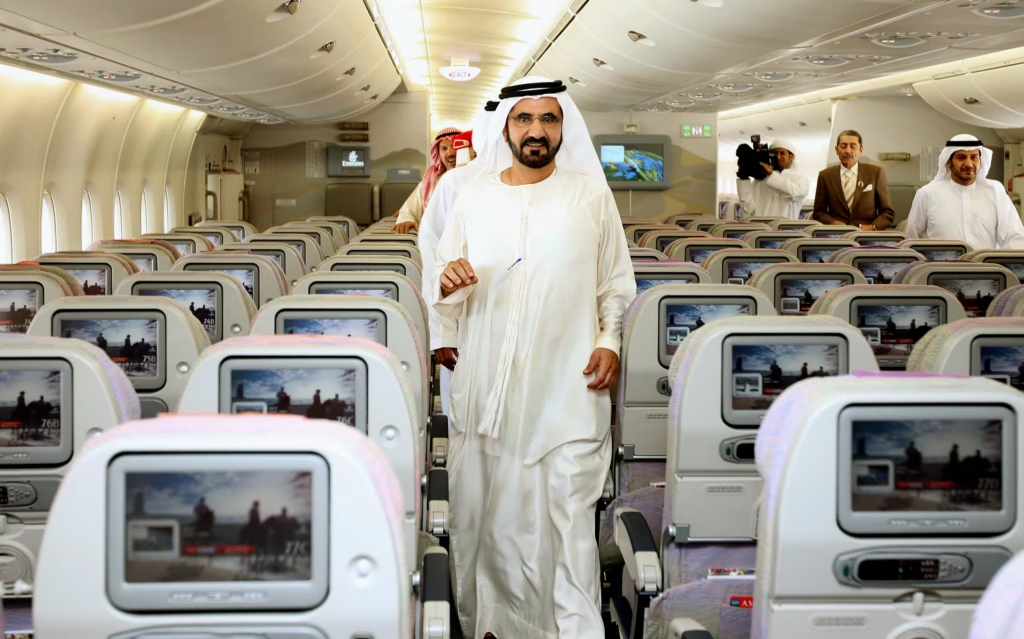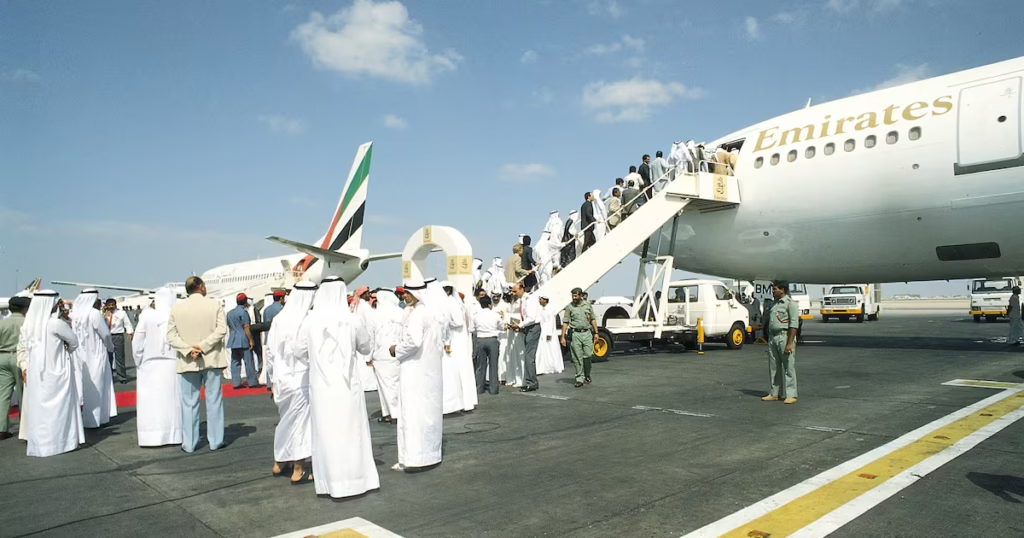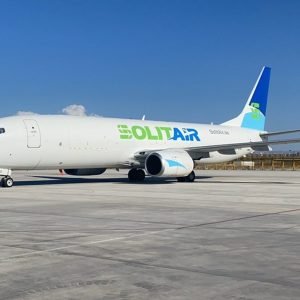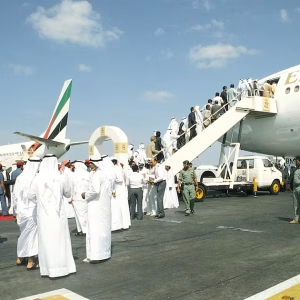On October 25, 1985, a modest aircraft carrying the name Emirates took to the skies for the very first time. That inaugural journey, known today as Emirates first flight, marked the beginning of one of the most remarkable success stories in global aviation history. From two leased planes and a handful of routes, Emirates has evolved into a world-class airline recognized for luxury, innovation, and excellence.
As the airline celebrates 40 years of flight, it’s worth looking back at how this incredible journey began, the milestones that shaped it, and how that first takeoff became the foundation of a global aviation empire.
The Vision Behind Emirates First Flight
In the early 1980s, Dubai was a growing city with big dreams but limited air connectivity. The region relied heavily on other carriers, and Dubai’s rulers realized that to attract trade, tourism, and investment, the city needed its own international airline.

The vision was clear: to create an airline that reflected Dubai’s ambition — global in outlook, efficient in operation, and excellent in service. However, starting an airline was no small task. With limited funds and no prior aviation infrastructure, the goal seemed daunting. Yet, the leadership’s determination transformed the dream into reality.
In March 1985, plans were finalized to launch Emirates. Within just five months, the airline prepared for takeoff. Its founders worked tirelessly to secure aircraft, hire crew, and establish routes. The result was Emirates first flight, a milestone that not only changed Dubai’s aviation landscape but also reshaped the future of air travel in the Middle East.

The First Takeoff October 25 1985
Emirates’ story officially began on October 25, 1985, when its first aircraft, an Airbus A300 B4, took off from Dubai International Airport bound for Karachi. The airline had only two leased aircraft at the time, an Airbus A300 and a Boeing 737 borrowed from Pakistan International Airlines.
Despite its humble beginning, that first flight symbolized something greater than a business venture. It represented hope, vision, and the determination of a city set to become a global aviation hub.
Emirates’ first flight was conducted with exceptional professionalism. The aircraft bore the distinctive livery that would soon become iconic: red, white, and green stripes inspired by the colors of the UAE flag. The service onboard reflected a promise of comfort and quality, setting the tone for what Emirates would come to stand for, excellence at every altitude.
Building an Airline From the Ground Up
Following its first successful flight, Emirates quickly began expanding. The team understood that to compete globally, the airline needed to grow rapidly while maintaining quality.
During its first year of operation, Emirates added new destinations such as Mumbai, Delhi, and Cairo. By focusing on connecting Dubai to key markets in Asia, the Middle East, and Europe, the airline started building a strong network that leveraged the city’s ideal geographical position.
Equally important was the company’s strategy to maintain financial independence. Unlike many other national airlines at the time, Emirates received no direct subsidies from the Dubai government. Instead, it was provided with a small seed capital of around $10 million, a sum that required disciplined management and smart reinvestment.
That decision proved vital. By operating with commercial discipline and entrepreneurial agility, Emirates laid the groundwork for sustainable growth. It wasn’t about growing fast, it was about growing smart.
Defining Excellence Early On
From the start, Emirates distinguished itself by focusing on service. The airline’s management believed that success wouldn’t come solely from low fares or rapid expansion but from offering a superior travel experience.
Every detail, from cabin design to onboard meals, was crafted with care. Emirates made comfort and service its calling card, even in the early days when resources were limited.
This focus soon paid off. Passengers began to associate Emirates with reliability and class, and within a few years, the airline became a preferred choice for travelers in the region.
In 1987, just two years after Emirates first flight, the company acquired its first owned aircraft, an Airbus A310. This marked a major milestone in its evolution from a fledgling carrier to an independent international airline. With its own fleet, Emirates gained greater flexibility to expand routes and improve service.
Expanding Horizons The 1990s
The 1990s were a transformative decade for Emirates. Building on the momentum of its early success, the airline embarked on ambitious expansion.
By the early 1990s, Emirates had added destinations across Europe, Asia, and Africa. Its network grew steadily, connecting Dubai to major global cities such as London, Frankfurt, and Singapore.
Even when faced with challenges, the airline demonstrated remarkable resilience. During the Gulf War in 1990–91, when many regional carriers suspended operations, Emirates continued to fly selected routes, reinforcing its reputation for reliability.
But what truly set the airline apart was its commitment to innovation. In 1992, Emirates became the first airline in the world to introduce individual entertainment screens for every passenger, in every class. This groundbreaking move transformed the in-flight experience and set a new standard for the industry.
The 1990s also saw Emirates strengthening its brand identity. The airline began to invest heavily in marketing and sponsorships, linking its image to excellence and prestige. From sports partnerships to international events, the Emirates logo became a symbol of luxury and ambition.

The Millennium Leap 2000 to 2010
As the new millennium began, Emirates was no longer a regional player, it had become a global leader. The airline entered the 2000s with bold plans to redefine long-haul travel.
One of its defining strategies was the adoption of a large, modern fleet. Emirates invested heavily in wide-body aircraft, including the Boeing 777 and Airbus A380. These planes became the backbone of the airline’s global operations, allowing it to connect Dubai to destinations across six continents.
The launch of the Airbus A380, in particular, marked a turning point. Emirates became the largest operator of the aircraft, using it to introduce an entirely new level of luxury including onboard lounges, private suites, and showers for first-class passengers. The move elevated air travel from mere transportation to a premium experience.
During this decade, Emirates also played a key role in transforming Dubai into one of the world’s busiest international hubs. The airline’s growth directly contributed to the expansion of Dubai International Airport, which became a global transit point connecting East and West.
By 2010, Emirates had built one of the most comprehensive networks in aviation, flying to over 100 destinations and employing tens of thousands of staff from more than 150 nationalities.
The Era of Innovation and Global Recognition
After 2010, Emirates continued to solidify its position as a pioneer in global aviation. The airline’s philosophy remained centered on service, comfort, and innovation.
The introduction of new cabin designs, advanced in-flight entertainment systems, and world-class hospitality reinforced its reputation as an industry leader. Emirates consistently ranked among the world’s best airlines in international awards and passenger satisfaction surveys.
Its marketing campaigns became iconic, featuring global ambassadors such as Jennifer Aniston and Cristiano Ronaldo. These efforts not only promoted the airline but also positioned Dubai as a glamorous and desirable travel destination.
Technology also became a major focus. Emirates invested heavily in digital transformation, enabling seamless online booking, mobile check-ins, and personalized services for travelers. Sustainability initiatives were introduced as well, aimed at reducing the airline’s environmental footprint through newer, more fuel-efficient aircraft and optimized operations.
By 2020, Emirates had become synonymous with luxury, innovation, and reliability, qualities that could all be traced back to the values established during Emirates first flight.
The Challenge and Comeback
The COVID-19 pandemic in 2020 posed one of the greatest challenges in aviation history. Global air travel came to a near standstill, and even a powerhouse like Emirates faced unprecedented difficulties.
However, true to its resilient spirit, the airline adapted quickly. It implemented strict safety protocols, modified operations, and played a key role in repatriation and cargo transport during the crisis. Emirates Cargo became essential in transporting medical supplies and vaccines across continents.
As travel restrictions eased, Emirates was among the first global airlines to bounce back. Its strong brand, loyal customer base, and efficient management allowed it to recover faster than many competitors. The airline used the period to strengthen its operations and prepare for the next phase of growth.
Forty Years of Soaring Success
As Emirates marks 40 years since that first flight, its achievements are extraordinary. From two leased aircraft and two destinations, the airline has grown into a global network spanning more than 150 cities on six continents.
It operates one of the youngest and largest wide-body fleets in the world, with over 250 aircraft. Its home base, Dubai International Airport, has become one of the busiest airports globally, handling millions of passengers each year.
Beyond size and numbers, Emirates’ success lies in its philosophy, a relentless pursuit of excellence. Every phase of its journey reflects innovation, adaptability, and an unshakable belief in quality.
The airline’s service remains world-class, its cabin crew multicultural and well-trained, and its in-flight experience unmatched. From economy class comfort to first-class luxury, Emirates continues to redefine what it means to fly.

Lessons From Emirates Journey
The story that began with Emirates first flight holds valuable lessons for businesses and dreamers alike.
- Start Boldly, Even Small: Emirates began with limited resources but boundless ambition. Vision and determination can turn small beginnings into global achievements.
- Commit to Quality: By focusing on service excellence rather than short-term gains, Emirates built a loyal customer base that powered its long-term success.
- Adapt to Challenges: Whether during wars, recessions, or pandemics, Emirates demonstrated agility and resilience.
- Leverage Opportunity: Dubai’s location between East and West became a natural advantage that Emirates used masterfully.
- Innovate Continuously: From in-flight entertainment to premium cabins, the airline stayed ahead by setting new standards in aviation.
The Future Continuing the Legacy
Looking ahead, Emirates shows no signs of slowing down. The airline continues to invest in next-generation aircraft, digital innovation, and sustainability. Future plans include adopting more fuel-efficient models, expanding to new destinations, and enhancing eco-friendly operations.
Dubai’s upcoming developments, including airport expansion and smart travel infrastructure, will further support Emirates’ mission to connect the world.
As air travel evolves, Emirates is positioning itself not just as an airline but as a global travel brand, one that connects cultures, economies, and people across continents.
Conclusion
When Emirates first flight took off in 1985, few could have imagined that it would spark a four-decade journey of innovation and success. What started as a small regional airline has become a symbol of global excellence, transforming Dubai into one of the most important aviation hubs in the world.
Forty years later, Emirates continues to soar, not just as an airline, but as a testament to what vision, leadership, and unwavering commitment can achieve. Its journey reminds us that every great success begins with a single step, or in this case, a single takeoff.
As Emirates celebrates its 40th anniversary, it carries the same spirit that powered its first flight, the courage to dream, the will to achieve, and the determination to keep soaring higher.
Do follow UAE Stories on Instagram
Read Next – Luxury VVIP Terminal Set to Transform Ras Al Khaimah International Airport














